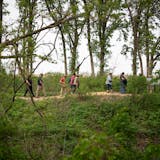Minnesota conservation officers targeted a type of illegal deer hunting in mid-November in the far north near Blackduck that is common, yet an uncommonly dangerous element of their work.
There were multiple violations, from shooting a deer from a motor vehicle and from a roadway to transporting loaded firearms, and all centered around one act: shining deer.
Scofflaws often use high-powered lights to locate deer, which freeze when spotlighted, making themselves easy targets.
Also common but perhaps little known is how the Department of Natural Resources conservation officers (COs) approach such a risky scenario. Shining deer under the cloak of darkness, often on a rural property, firepower close, carries a threat that transcends the day-to-day duty of most COs.
Across the state, officers rely on the coordination of eyes in the air and in the field to catch perpetrators.
COs consider landowner reports of shining or shots fired or even dead whitetails in deciding where to patrol at night, said Maj. Robert Gorecki. Aviation officers can cover large swaths of territory. Pilot and CO Bob Geving of Mankato said some of his shining details have ranged from a 10- to 40-mile radius, and he can expect six to eight scheduled missions from autumn into early winter.
While some violators have upgraded to less-conspicuous light sources to attract deer, COs have an advantageous perspective from above, and use night vision optics and GPS to relay information to teams in the vicinity of suspicious behavior.
"We are hoping for more tools," said Geving, who has been an aviation officer since 2007.
![Three weeks ago, Octavio Rodriguez switched from making transmission parts to casting parts for hospital bed brake assemblies at Twin City Die Castings. ] GLEN STUBBE • glen.stubbe@startribune.com Thursday, April 9, 2020 How employee-owned Twin City Die Casting, which just laid off 40 production workers of its 250 employees in what was supposed to be a good year, is trying to accelerate its pivot to growing medical parts business for ventilators, hospital beds, etc as it copes with instan](https://arc.stimg.co/startribunemedia/WNZYKGTZ5IYMUCO3KI5TR3N7WI.jpg?&w=80&ar=1:1&fit=crop)

djoles@startribune.com As boaters flock to Minnesota lakes and rivers this holiday weekend for the unofficial kick-off to the boating season, they'll face more inspections in and out of the water as local cities and counties ramp up their work to stop the spread of invasive species. Across the metro, more boat accesses will be staffed by watercraft inspectors thanks to $10 million funneled to county government programs this year, up from $4.5 million the state allocated last year. ORG XMIT: MIN1505222156290209 ORG XMIT: MIN1506021218440580](https://arc.stimg.co/startribunemedia/34QSKO44B2XKVNUZCO5SLJQSLY.jpg?&w=80&ar=1:1&fit=crop)
